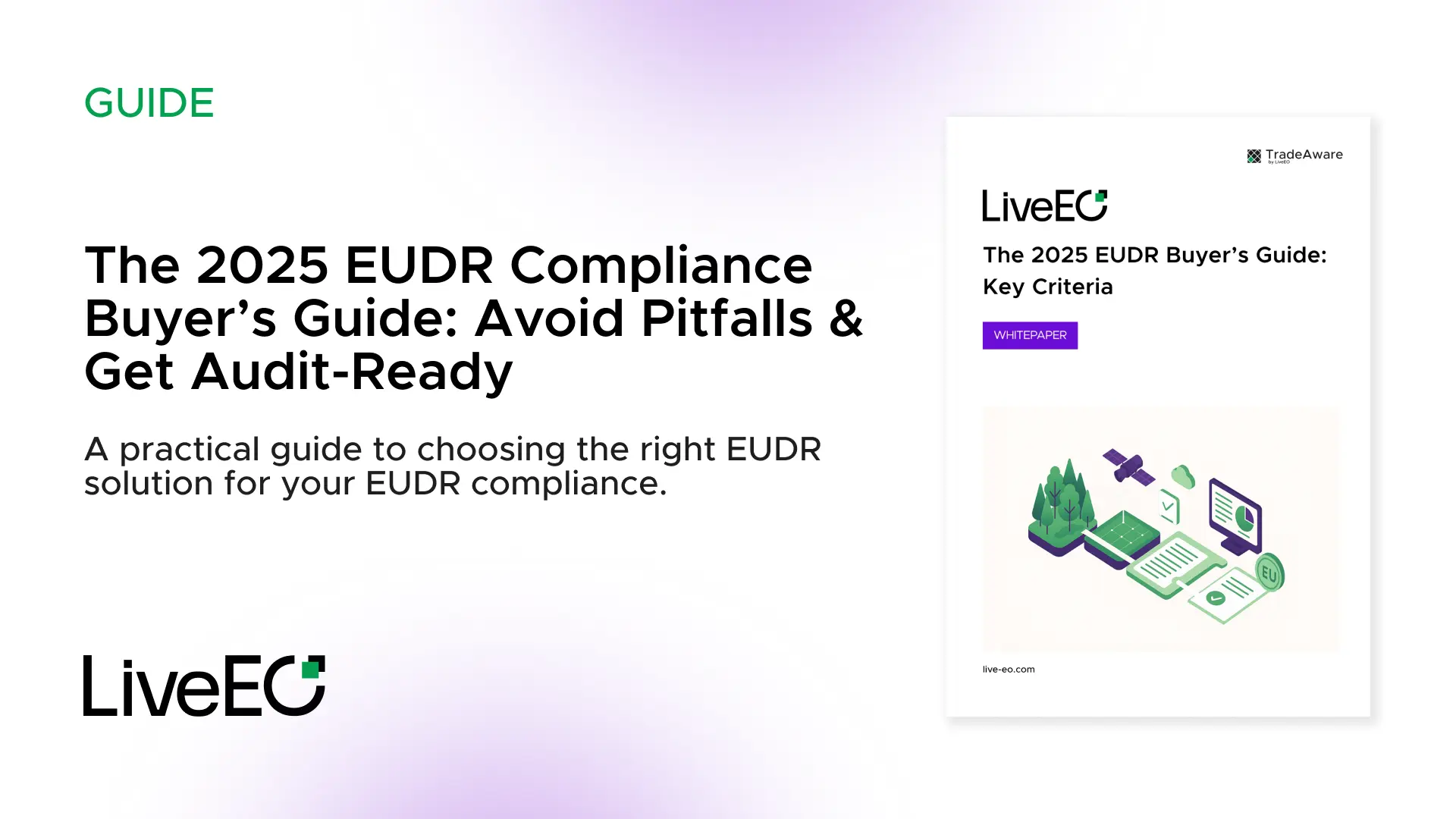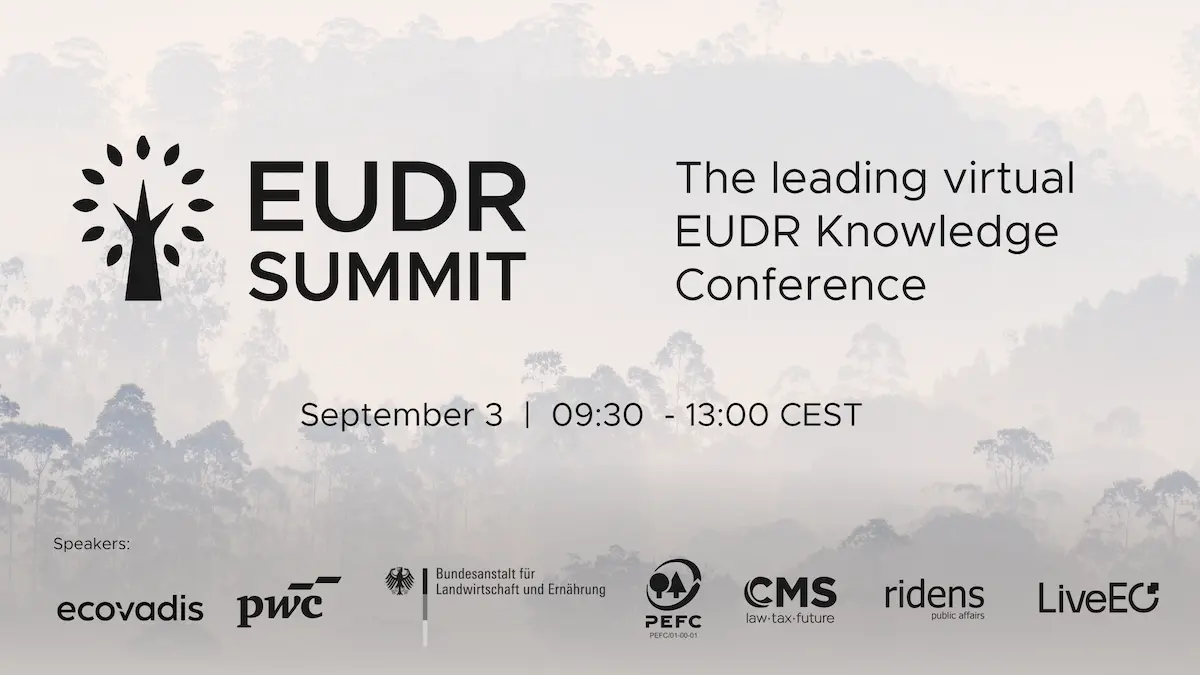Accurate Deforestation Checks. Anywhere, Anytime.
Automate deforestation risk analysis with TradeAware’s advanced satellite imagery and AI-powered insights. Reduce disruptions, safeguard revenues, and elevate operational efficiency ahead of EUDR.

















Don't Leave Your Supply Chain to Guesswork
Inaccurate deforestation data doesn’t just mean non-compliance—it can create costly downstream risks like:
Risk of Wrongful Supplier Exclusion
High false positive rates in open-source data can mistakenly classify compliant suppliers as non-compliant. This leads to unnecessary supply chain restructuring, increasing costs and operational inefficiencies. Moreover, the loss of trusted suppliers disrupts the flow of goods, threatening revenue and market share in EU markets where compliance is critical.
Risk of Fines and Market Exclusion
False negatives in deforestation assessments expose companies to significant compliance risks. Missing non-compliance issues can result in severe regulatory penalties, including fines exceeding 4% of EU turnover, and jeopardize a company’s ability to operate within EU markets, harming its reputation and financial stability.
Delays Due to Manual Risk Assessments
Evaluating deforestation risks across vast and remote areas is an arduous task that often relies on localized actors and manual processes. These assessments are time-intensive, lack objectivity, and must be repeated for every new supplier, creating bottlenecks in due diligence. Such delays can hinder compliance efforts and slow the entry of products into the EU market.
Introducing: Precision Analytics
TradeAware’s high-resolution satellite imagery and advanced AI analytics deliver precise insights into land use, verifying that products are sourced from deforestation-free areas.

How it Works
Precision Analytics is a functionality within the TradeAware app. Utilizing pre-configured regional models, it enhances data accuracy by tailoring its analysis to specific geographical nuances, reducing the risk of false positives and negatives.
The Most Accurate and Scalable
Deforestation Assessment

Method Aligned with EUDR Definitions
By leveraging advanced methodologies aligned with EUDR definitions, we ensure the highest accuracy in deforestation risk assessments while meeting regulatory requirements.
Our specialized regional models offer pre-configured solutions tailored to specific geographies, minimizing errors and enhancing decision-making.
Additionally, our rigorous quality control mechanisms ensure consistent and reliable analysis across all evaluations.
Global Coverage and Near-Instant Results
A highly automated process delivers rapid assessments, making it ideal for monitoring large and geographically distributed areas.
This capability enables businesses to quickly evaluate new suppliers and maintain compliance without delays.
Integrations via API or App-Interface allow seamless activation and scaling of assessments to meet operational needs.


All Actionable Insights in One Place
TradeAware consolidates supplier insights into a single platform, enabling businesses to manage compliance decisions efficiently.
Companies can greenlight compliant suppliers or flag them for further investigation with minimal delay.
Additionally, supplier statuses can be seamlessly fed into other systems, streamlining compliance workflows and ensuring data consistency across operations.
Precision Analytics, On Demand
One Click: Select individual plots and request Precision Analytics with the click of a button.
User-Friendly Interface: The easy-to-use application requires no prior knowledge of geo information systems.
Quickly Receive Results and Act: Precision Analytics results are available in your dashboard and can be acted upon swiftly.
Trigger Precision Analytics from your existing ERP: Enrich your existing setup with our advanced analytics to ensure EUDR compliance.
Bulk Deforestation Checks: Run deforestation analysis of the areas of interest on scale.
Instant Supplier Status Updates: Instantly receive supplier status in your system.
TradeAware in Numbers
1 platform
for all EUDR aspects
95%
reduction of misclassifications
Open Source Data vs Proprietary
Deforestation Analytics: A Case Study
.webp)
How reliable is open-source data for EUDR compliance?
Our comprehensive case study in Borneo, a key region for palm oil and other EUDR commodities, reveals the limitations of open-source solutions.
The study shows that LiveEO’s Precision Analytics outperformed open-source data by reducing error rates by 42%, ensuring higher accuracy and minimizing regulatory risks. This enhanced accuracy could safeguard €55 billion in exports across industries.
Read the full case study for more insights.
Why Accuracy Matters: Precision vs. Open-Source
Open-Source Data
Capabilities

Precision Analytics
Capabilities
Learn more about EUDR Compliance
Navigate the EUDR regulation with ease—explore our guides and solutions.

Learn more about TradeAware
TradeAware is LiveEO's comprehensive platform designed to streamline EUDR compliance. It offers precise deforestation assessments, integrated legality checks, and seamless system integration, enabling businesses to manage supply chain risks effectively and ensure adherence to EUDR standards.
Visit TradeAware Page
The EUDR Handbook
This handbook provides in-depth insights into the European Union Deforestation Regulation (EUDR), offering expert guidance on compliance strategies and risk mitigation. It covers topics such as supply chain mapping, geolocation data verification, and actionable steps to help businesses avoid legal and financial pitfalls associated with non-compliance.
Download
EUDR Legal Requirements Guide
Developed in collaboration with CMS, a leading global law firm, this guide delves into the legal obligations under the EUDR. It provides a detailed breakdown of due diligence requirements, necessary documentation, and practical strategies to ensure your supply chain remains deforestation-free, helping businesses navigate the complex legal landscape of the EUDR.
Contact us
We are here to support you on your EUDR journey. Please fill out the form and we'll get back to you.
Frequently Asked Questions
What is the EU Deforestation Regulation (EUDR)?
The EUDR is a law enacted by the EU to prevent the placing of commodities linked with deforestation and forest degradation onto the EU market or exporting them from the EU.
It aims to reduce greenhouse gas emissions resulting from deforestation and aid in the fight against global biodiversity loss.
Why is precise deforestation data crucial for EUDR compliance?
Accurate deforestation data is essential for complying with the European Union's Deforestation Regulation (EUDR), which mandates that commodities like rubber, palm oil, cattle, coffee, cocoa, and timber are not sourced from land deforested after December 31, 2020.
Reliable data ensures that companies can verify their supply chains are free from deforestation, thereby avoiding significant penalties, preventing supply chain disruptions, and maintaining market access within the EU.
Without precise data, businesses risk non-compliance, which can lead to legal and financial repercussions.
What are the limitations of open-source deforestation data in ensuring compliance?
Open-source deforestation data, while widely accessible, often lacks the accuracy and detail required for EUDR compliance.
These datasets may struggle to detect critical land-use changes, leading to false positives—incorrectly identifying compliant areas as deforested—or false negatives—failing to detect actual deforestation.
Such inaccuracies can result in unjustly cutting off supply chains or exposing companies to substantial risks of non-compliance, respectively.
How do proprietary deforestation analytics enhance compliance efforts compared to open-source data?
Proprietary deforestation analytics offer higher resolution and real-time monitoring capabilities, providing accurate detection of land-use changes.
These advanced systems reduce the risks of false positives and negatives, thereby improving overall compliance efforts.
By investing in advanced geospatial data analytics, companies can transform compliance into an opportunity for improved operational efficiency, better supply chain transparency, and enhanced brand reputation.
What are the potential risks of relying solely on open-source deforestation data for compliance?
Relying solely on open-source deforestation data can lead to several risks, including:
- False Positives: Incorrectly identifying compliant areas as deforested, leading to unnecessary supply chain disruptions.
- False Negatives: Failing to detect actual deforestation, exposing companies to non-compliance penalties.
- Delayed Data Updates: Lack of real-time monitoring can result in outdated information, hindering timely compliance actions.
These risks underscore the importance of investing in more precise and reliable data sources for compliance purposes.
Why is distinguishing forest cover loss from land use change important for EUDR compliance?
Accurately differentiating between forest cover loss and land use change is critical for EUDR compliance because not all tree loss qualifies as deforestation under the regulation.
The EUDR specifically targets land that has been permanently converted from forest to other uses, such as agriculture, infrastructure, or mining, after December 31, 2020. However, forest cover loss can occur for various reasons that do not necessarily indicate deforestation.
For example, sustainable forestry practices, seasonal canopy changes, and natural disturbances (such as storms or wildfires) may lead to temporary reductions in tree cover without resulting in long-term land-use change. Open-source deforestation data often struggles to make this distinction, leading to false positives (wrongly flagging sustainable activities as deforestation) or false negatives (failing to detect actual illegal land conversion).
For businesses, misinterpreting forest cover loss as deforestation can lead to unnecessary supplier exclusions and supply chain disruptions, while failing to detect real land-use change could result in non-compliance penalties.
High-accuracy deforestation monitoring solutions—such as Precision Analytics—use AI-driven models and high-resolution satellite imagery to analyze historical land-use patterns, ensuring that only genuine deforestation events are flagged. This minimizes errors, reduces compliance risks, and prevents disruptions in global commodity trade under the EUDR framework.
Other stories











.webp)
